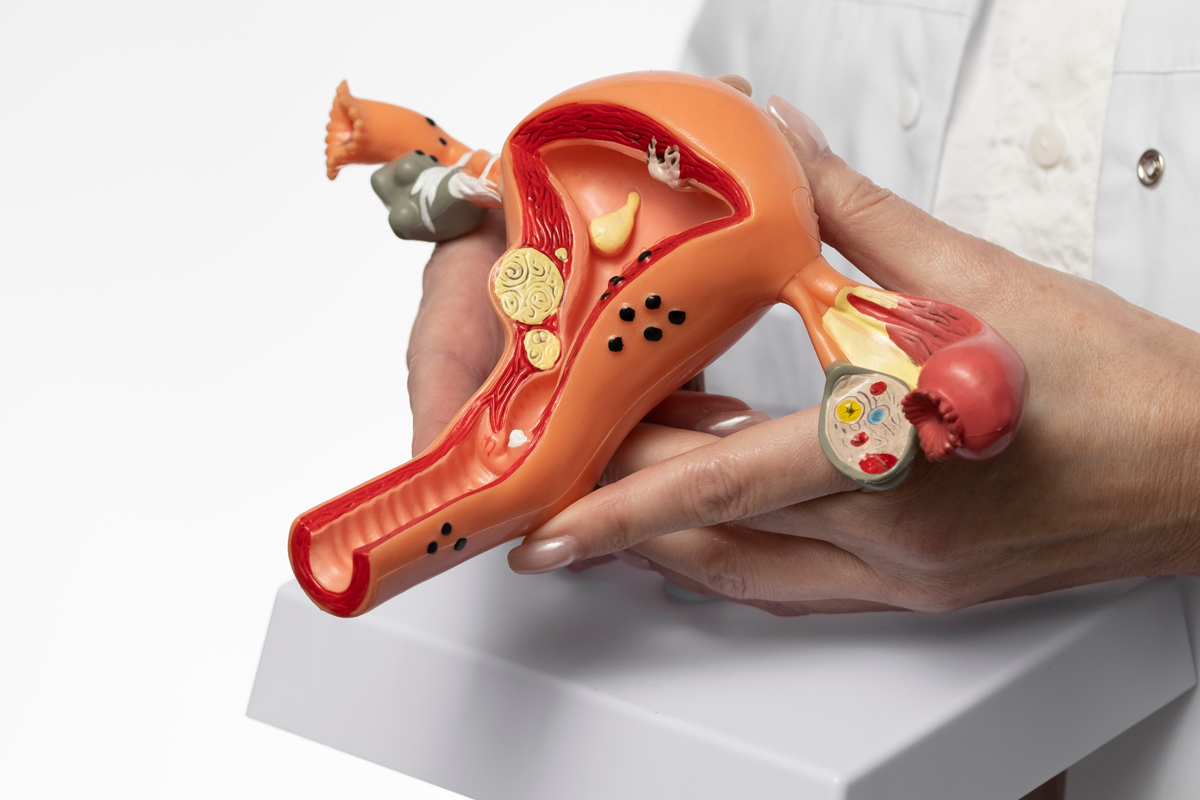 March 17, 2023
March 17, 2023
Endometritis Explained: Symptoms – Diagnosis and Treatment Options
Are you tired of feeling like you're constantly battling your own body? Do you dread your period each month because of the pain and discomfort it brings? If so, you're not alone. Endometriosis affects millions of women worldwide and causes various symptoms that affect their daily life. In this blog, we'll discuss the topic of endometriosis, understanding what it is, its symptoms, and the treatment options. Whether you're dealing with endometriosis or simply curious about this often-misunderstood condition, read on to learn more.
Q: What is endometriosis?
A: Endometriosis is a medical condition where tissue similar to the lining of the uterus grows outside the uterus, causing pain and discomfort. This tissue can grow on the ovaries, fallopian tubes, outer surface of the uterus, intestines, or other organs in the pelvis. The tissue that grows outside the uterus also thickens and breaks down in response to hormonal changes during the menstrual cycle. However, unlike the tissue inside the uterus, it cannot exit the body, which can lead to the formation of painful cysts, and other complications.
Q: What causes endometriosis?
A: The exact cause of endometriosis is still not fully understood, but several theories attempt to explain its development.
One theory is that during menstruation, some menstrual blood containing endometrial tissue flows backward through the fallopian tubes and into the pelvic cavity, where it attaches and grows on other organs and tissues, causing endometriosis. This is known as retrograde menstruation.
Some researchers believe endometriosis may be caused when the immune system fails to recognize and eliminate the endometrial tissue growing outside the uterus.
There may be a genetic tendency to endometriosis, as the condition tends to run in families.
Exposure to certain chemicals or toxins, such as dioxins, may also increase the risk of developing endometriosis.
Endometriosis is an estrogen-dependent disease which is influenced by estrogen levels in the body. High levels of estrogen or a hormonal imbalance may lead to the development of endometriosis.
It's important to note that while there are several theories about the cause of endometriosis, there is no clear answer. More research is needed to fully understand the condition and develop effective treatments.
Q: What are the symptoms of endometriosis?
A: Endometriosis can cause many symptoms, varying from person to person. Some women with endometriosis may experience mild symptoms, while others may have severe symptoms that significantly impact their quality of life.
Some of the most common symptoms of endometriosis include:
- Pelvic pain: This is the most common symptom of endometriosis. The pain can be severe and may occur before, during, or after menstruation. It may also occur during sex, bowel movements, or urination.
- Heavy or irregular periods: Women with endometriosis may experience heavier or longer periods than usual and irregular bleeding.
- Fatigue: Some women with endometriosis may experience fatigue and low energy levels, which can be caused by chronic pain, anemia, or hormonal imbalances.
- Painful bowel movements or urination: Endometrial tissue can grow on the bowel or bladder, causing pain during bowel movements or urination.
- Back pain: Endometriosis can cause pain in the lower back, especially during menstruation.
- Digestive problems: Some women with endometriosis may experience nausea, bloating, constipation, or diarrhoea, especially during menstruation.
- Infertility: Endometriosis can make it difficult for a woman to get pregnant. Up to half of women with endometriosis experience infertility.
Q: What should I do if I think I have endometriosis?
A: If you suspect that you have endometriosis, it's essential to talk to your doctor. Here are some steps you can take:
- Schedule an appointment with your doctor: If you have symptoms that may suggest endometriosis, such as painful periods, chronic pelvic pain, painful intercourse, or infertility, make an appointment with your doctor.
- Prepare for your appointment: Before your appointment, write down any symptoms you're experiencing and any questions you have. This will help ensure that you get the most out of your appointment.
- Discuss your symptoms with your doctor: Be open and honest with your doctor about how long you've been experiencing them and how they affect your daily life.
- Undergo a physical exam: Your doctor may perform a physical exam to check for abnormalities in your pelvis or uterus.
- Consider further testing: If your doctor suspects endometriosis, they may recommend further testing, such as an ultrasound, MRI, or laparoscopy.
Always remember that early diagnosis and treatment of endometriosis can relieve symptoms and prevent complications, so it's important to talk to your doctor if you suspect you may have the condition.
Q: How is endometriosis diagnosed?
A: Endometriosis is typically diagnosed through medical history, physical examination, and imaging tests. Here are some common diagnostic methods:
- Medical history: Your doctor will ask you about your symptoms, such as pelvic pain, painful periods, pain during sex, and infertility, as well as your medical and menstrual history.
- Pelvic exam: Your doctor will perform a pelvic exam to feel for any abnormalities, such as cysts or scars, and to check for tenderness or pain.
- Imaging tests: Imaging tests such as ultrasound, magnetic resonance imaging (MRI), or computed tomography (CT) scans may be used to visualize the pelvic area and identify endometriosis lesions.
- Laparoscopy: Laparoscopy is a surgical procedure where a thin tube with a camera and light is inserted through a small incision in the abdomen to view the pelvic organs directly. This is the only definitive way to diagnose endometriosis.
- Biopsy: During laparoscopy, your doctor may also take a tissue sample (biopsy) for analysis to confirm the diagnosis.
It's important to note that endometriosis can be challenging to diagnose and may be mistaken for other conditions. If you are experiencing symptoms of endometriosis, it's essential to speak with your doctor to receive a proper evaluation and diagnosis.
Q: What are the treatment options for endometriosis?
A: The treatment for endometriosis depends on the severity of the symptoms and the patient's desire for fertility. Your doctor can help determine the best course of treatment for you based on your circumstances. Some standard treatment options are :
- Hormonal therapy: Hormonal therapy such as birth control pills, progesterone-only pills, or intrauterine hormonal devices (IUDs) can help reduce the growth and activity of endometrial tissue and relieve symptoms.
- Pain management: Over-the-counter pain relievers such as ibuprofen or naproxen can help relieve menstrual cramps and other pain associated with endometriosis.
- Surgery: Laparoscopic surgery can be performed to remove endometrial tissue or scar tissue. In more severe cases, a hysterectomy may be recommended, which involves the removal of the uterus and sometimes the ovaries.
- Fertility treatment: In cases where endometriosis is causing infertility, fertility treatments such as in vitro fertilization (IVF) or intrauterine insemination (IUI) may be recommended.
It's important to note that women with endometriosis need to work closely with their doctors to develop an individualized treatment plan that meets their unique needs.
Q: Can endometriosis lead to infertility?
A: The exact mechanism by which endometriosis causes infertility is not fully understood, but it is thought to interfere with fertility in the following ways :
- Blockage of the fallopian tubes: Endometrial tissue can grow on or near the tubes, causing scarring or blockage that can prevent the egg and sperm from meeting.
- Changes in the uterus and cervix: Endometrial tissue can grow in the uterus or cervix, causing inflammation and scarring that can interfere with the implantation of a fertilized egg.
- Hormonal imbalances: Endometriosis can impact hormonal balance, leading to changes in ovulation or the ability of the uterus to support a pregnancy.
Q: Are there any lifestyle changes that can help manage endometriosis symptoms?
A: Yes, several lifestyle changes can help manage the symptoms of endometriosis. While these changes may not cure the condition, they can help alleviate pain and discomfort and improve quality of life. Here are some lifestyle changes that may be helpful:
- Exercise regularly: Regular exercise can help reduce inflammation, improve circulation, and boost mood. Aim for at least 30 minutes of moderate exercise most days of the week.
- Eat a healthy diet: A balanced diet with plenty of fruits, vegetables, whole grains, and lean protein can help reduce inflammation and improve overall health.
- Manage stress: Stress can worsen endometriosis symptoms, so finding ways to manage stress is essential. Yoga, meditation, deep breathing, and other relaxation techniques can be helpful.
- Get enough sleep: Getting enough restful sleep can help reduce inflammation and improve overall health. Aim for 7-8 hours of sleep per night.
- Avoid alcohol and caffeine: Both alcohol and caffeine can worsen endometriosis symptoms, so it's best to avoid or limit them.
Appropriate medical treatment and care are crucial to avoid any associated medical complications.
To book an appointment, contact us at +91-9540 114 114.
 March 17, 2023
March 17, 2023


